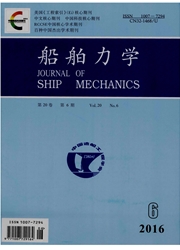

 中文摘要:
中文摘要:
为了研究三维水翼定常空泡特性,利用低阶面元法结合非线性理论对三维机翼的空泡范围和形状进行了计算分析。根据运动学边界条件和动力学边界条件,采用压力恢复闭合的空泡模型结合面元法分别预报了矩形、椭球型和无限展长三维水翼的空泡性能。由计算结果可知:(1)对于三维矩形水翼在展向各水翼剖面空泡长度和厚度不同,空泡长度从展向中心向水翼两侧逐渐减小。空泡数越小,空泡区域就越大,且水翼面上的空泡体积的变化率愈大。(2)三维椭圆水翼在翼梢处计算出的压力分布有时并不满足空泡面的动力学边界条件,在尾缘处上下表面甚至出现较大压力差,存在压力"跳跃"。(3)无限展长三维水翼中心剖面处空泡厚度和长度分布与相应的二维水翼的空泡厚度分布基本一样。
 英文摘要:
英文摘要:
In order to study the steady cavitation characteristics of three-dimension hydrofoil, whose cavitation area and cavitation shape are calculated and analyzed by low-order panel method and nonlinear theory. According to kinematic and kinetics boundary conditions, the pressure recovery closed cavitation model combined with panel method were used to compute the cavitation perfor- mance of 3-dimension hydrofoil of rectangle, ellipse ball and spanwise infinity. The results show that: (1) For three-dimensional hydrofoil, the lengths and thicknesses of cavitation are different at each spanwise section of the hydrofoil, and cavitation length reduces gradually from the center to the sides of hydrofoil spanwise. The cavitation region of hydrofoil and the change rate of the cavitation volume increase along with the decrease of cavitation number; (2) The pressure distribution predict- ed in the tip of elliptic hydrofoil does not accord with dynamic boundary conditions on cavitation surface, and pressure jump exists in the tailing edge; (3) The cavitation thickness and length distri- bution of the infinite span three-dimensional hydrofoil at the middle section is basically the same as the result of the two-dimensional hydrofoil.
 同期刊论文项目
同期刊论文项目
 同项目期刊论文
同项目期刊论文
 期刊信息
期刊信息
